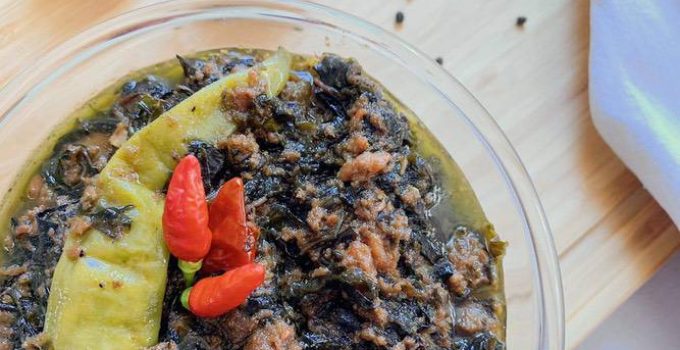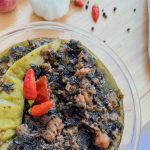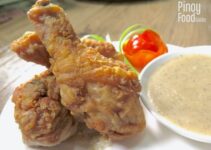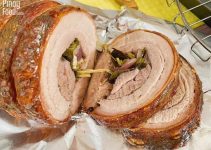Laing is a dish especially known in the Bicol region but is also well-admired all around the country. This dish is not hard to find as it’s something often seen in local restaurants or carinderia along the streets.
So with this, you’ll be sure to find different kinds of people who cook this in subtle different ways and maybe find laing dishes you like, and laing dishes you do not.
But here in this article, we are set to teaching you how to cook this simple recipe of laing that’s sure to please your taste buds. After all, this dish is not so hard to cook and is surely delicious. The good thing about this recipe is you can easily change things up to your own liking so don’t even fret.
So ready up, as we’re about to learn more about this special laing recipe!
What is Laing?
If we’re to talk about the dozens of Filipino cuisines we like, I’m almost sure that Laing is one dish which we’re surely going to mention most of the time.
This unique dish is made of dried whole or shredded taro leaves or gabi leaves mixed with coconut milk, some meat, chilies, and other seasonings.
This dish forms what is seemingly chaotic when we look at it but is uniformly dancing in our taste buds when we eat it. No doubt that anyone who loves to try out different kinds of food would be curious about this dish.
This delicacy originated from a place mentioned here in the article earlier–of course–Bicol. The region is popular for having extra special and delicious, spicy dishes which would surely peak anyone’s interest.
And laing is one of those dishes which does not disappoint. But compared to common recipes outside Bicol, the authentic laing typically uses whole taro leaves, instead of the usual shredded ones.
Ingredients You’ll Need
Dried Taro/ Gabi Leaves
This is the main ingredient of our dish. It is important to take note that we specifically use the dried ones. Good news is we don’t have to dry the leaves ourselves since dried leaves are already sold in the marketplace.
Pork
You can cook laing without this but I suggest you do. I would even recommend to use pork belly because of the fat content. Rendered fat from pork gives a ton of flavor to this dish.
Shrimp
Shrimp is another optional ingredient but having this doesn’t only add flavor but it makes the whole dish visually special. You know you’re eating good laing when you see shrimp with the gabi leaves.
Bagoong
Some recipes don’t add bagoong or shrimp paste in this recipe, I say it’s vital. Aside from using this as seasoning, this condiment will give your laing the umami flavor we’re after. You can use bottled bagoong found in supermarkets.
Chili
Chilies are a part of the recipe. But remember that some people do not want too much spiciness on their dish, so feel free to adjust the number of chilies used in this recipe. Siling labuyo is originally used in this dish, but you can also use Bird’s Eye Chili or Thai Chili.
Coconut milk
Coconut milk and coconut cream can be bought and is readily available in most markets. But if you want fresher ingredients for this dish and aim for a creamier laing, you can make both the coconut milk and coconut cream by yourself since you will be able to have more control on how you want it to be.
This article will help you learn more about coconut milk (gata) and coconut cream (kakang gata) and how to make them: Gata Vs Kakang Gata.
Aside from these, we will also be using other regular pantry ingredients like garlic, onion, and ginger. If you are filling up your pantry, here’s a handy shopping guide:
Equipment You’ll Need
- Cooking Pan (Kawali)- Laing is a one-pan dish and we will be using a regular Filipino kawali in the whole cooking process. A substitute to kawali would be any deep cooking pan or a shallow cooking pot or casserole.
In need of kitchen tools and equipment? Read this before you buy:
How to Cook Special Laing
You might think that cooking laing is a difficult process based on how it looks, but really, it is just as simple as putting and mixing the ingredients together. All you have to do is combine your initial ingredients, and let it boil until the ingredients have a good consistency and until the meat is nice and tender.
After that, we will just add in the gabi leaves and some chilies. Take note, we recommend in this recipe that you use dried gabi leaves. Leave the pot cooking until the taro leaves absorb the coconut milk. A good indicator that the coconut milk is absorbed is when the taro leaves look darker from before.
When that’s done, the last step is to just pour in the coconut cream and some chilies again to finish and spice things up. You will know that your cooking is done when fat oil is rising from the cooking pot, so keep an eye on that.
That’s it! After just a few simple steps done, you’re ready to serve your special laing to your loved ones! You might want to try out another Bicolano dish called the Bicol Express, we have a recipe as well.
Cooking Tips
- When cooking with coconut milk and coconut cream, be mindful of the temperature. Make sure you cook over a gentle simmer so that the milk fat won’t separate.
- There are a couple of ways to make sure you’re laing don’t give off an itchy mouth feel, refer to this article: How To Make Taro Leaves Not Itch.
- When cooking with pork, make sure you brown the pork and let it render fat.
Frequently Asked Questions (FAQs)
Can Laing Be Frozen? How to Store and Reheat?
In case of leftovers or if you want to enjoy laing for later, you may be wondering about the best practice for its storage and preservation.
Yes, laing can be frozen. And with proper storage, freezing will prolong its shelf life to up to a month while it will only take up to 5 days when you simply store it in the refrigerator.
Place the laing in an airtight container when freezing it. When you’re about to reheat, remember to thaw in the refrigerator or chiller overnight. Reheat on a pan over low heat or on a microwave for 1 minute. You may add additional coconut milk in case the laing dried up.
Why Use Dried Gabi Leaves?
We mentioned earlier that it is important to use dried gabi leaves for this recipe.
This is because fresh gabi leaves contain toxins which causes the mouth or throat to itch a lot. While fresh gabi leaves are a viable ingredient in making laing, it needs a longer process of cooking to remove those toxins from the leaves.
Dried leaves, however, are rid of these toxins and are commonly available in your local markets, so this is the easier choice when cooking special laing.
Where To Find Gabi Leaves?
Taro or gabi is a prevalent plant in tropical and subtropical regions, including Southeast Asia. Dried taro leaves are readily available in Philippine supermarkets and other Asian stores worldwide.
Is There A Substitute For Gabi Leaves?
Spinach leaves can be a substitute for this dish. Do take note though that this will cook faster so you have to reduce the coconut milk first before adding the spinach.
What Other Meat Can Be Added?
Some laing recipes a tried have dried or smoked fish mixed in the dish. You have the option to try this as well.
How to Serve Laing
Laing is best served with freshly cooked white rice. Since this recipe already has pork and shrimp, it is considered as a full meal in itself. However you can also add grilled or fried meats to accompany this dish.
Other Ginataan Recipes
- Kinunot Na Pagi (Flaked Stingray in Coconut Cream) Recipe
- Ginataang Papaya Recipe
- Authentic Sinantolan (Ginataang Santol) Recipe
- Ginataang Kalabaw (Carabeef in Coconut Milk) Recipe
- Ginataang Tambakol (Tuna in Coconut Milk) Recipe
For a quick reference about this recipe, see the recipe table below:
Special Laing Recipe
Equipment
- Cooking Pan (Kawali)
Ingredients
- 100 g (3.5 oz) dried gabi (taro leaves)
- ¼ kg (8.8 oz) pork belly or pork shoulder, thinly sliced
- ¼ cup shrimp, peeled and thinly sliced (or whole if you prefer)
- 6 cups coconut milk (gata)
- 2 cups coconut cream (kakang gata)
- 1/2 cup shrimp paste (bagoong)
- 3 to 4 pieces red (labuyo) chilis, sliced
- 2 to 3 pieces green (finger chilis)
- 1 piece onion, sliced
- 1/2 cup ginger, sliced
- 8 cloves garlic, crushed
Instructions
- In a cooking pan, combine the coconut milk, pork, shrimp, shrimp paste, ginger, onion, and garlic.
- Heat the pot over low to medium heat and let boil.
- Once the mixture starts to boil, gently stir to mix the ingredients. Cover the pot and simmer for 15 to 20 minutes. Stir occasionally to prevent the ingredients from sticking on the bottom of the cooking pot.
- Add-in the dried taro (gabi) leaves and green chilis. Do not stir. Let it stay for about 20 to 30 minutes until the leaves absorb the coconut milk. Gently push the leaves down so that it can absorb more coconut milk.
- Once the leaves absorb the coconut milk, stir the leaves and then continue to cook for 10 minutes.
- Pour-in the coconut cream into the cooking pot.
- Add-in the red chilies and stir then cook until it renders fat (until you see a visible oily layer).
- Remove from heat and transfer to a serving plate and enjoy!
Notes
Nutrition
Pin and save this recipe to your Pinterest account! Click on the Pin button above 🙂
Thank you and I hope you find this article useful! It’ll mean a lot if you RATE THE RECIPE by clicking the stars and SHARE THIS TO YOUR FRIENDS! 🙂




